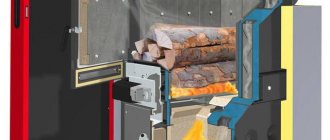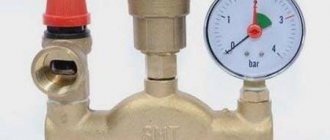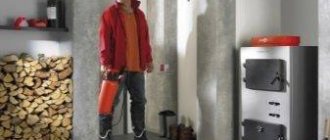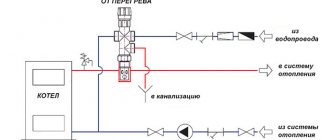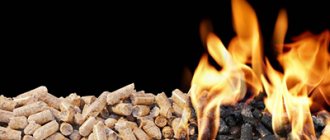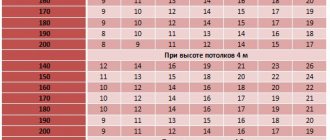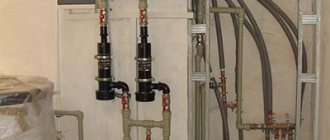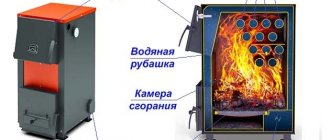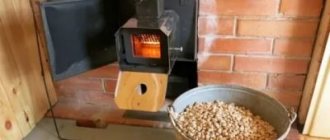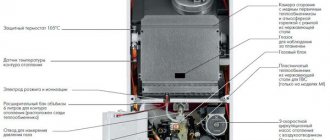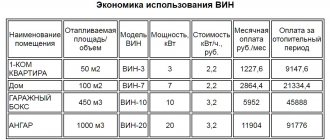In 2000, engineer Edmuntas Štropaitis received a patent for a special type of long-burning solid fuel boiler, in which pellets were used instead of coal, firewood or peat.
At that time, such fuel, which was cylinders of pressed sawdust Ø6-8 mm and up to 50 mm long, was exotic, however, the inventor saw two obvious advantages in it: firstly, there was a use for huge volumes of waste from wood processing industries, and secondly , the supply of granules into the combustion chamber can be dosed with a screw, which means it is easy to automate the operation of the boiler. As time has shown, Stropaitis was not mistaken in his assumptions: today pellet heating boilers are in demand all over the world. Please note that they have their own characteristics that you should definitely be aware of.
Operating principle and design of pellet boilers
According to the principle of operation, pellet boilers are similar to standard solid fuel boilers. The differences lie in the screw supply of pellets and in the smaller size of the combustion chamber, since the lower temperature of the exhaust gases (not exceeding 180-200 degrees) allows for more efficient use of heat exchangers, primarily in convection channels. In other words, the coolant in the heating system is heated not only due to the direct combustion of the fuel, but also due to the heat going into the hot smoke pipe.
The pellet boiler device includes:
- Combustion chamber.
- Burner.
- Heat exchanger.
- Grate.
- Fan.
- Container for ash.
- Bunker for pellets.
- Screw.
- Control block.
Semi-automatic solid fuel boilers.
The main element that distinguishes such boilers from conventional ones is the presence of a control unit that controls the operation of the fan. A fan is needed to force air into the boiler and maintain combustion at the required level. By changing the fan speed, you can change the speed at which the fuel burns. It should be understood that when fuel combustion slows down, the power supplied from the boiler to the heating system decreases. This will lead to a decrease in temperature inside heated rooms. Semi-automatic boilers can operate on one load for up to several days, but their power is reduced so much that it is only sufficient to protect the system from defrosting.
The ability to modulate power allows you to save it. For example, you can program the boiler to reduce power while you are at work, and before you arrive, the power will increase and the house will become warmer. Or connect external temperature sensors and adjust the operation of the boiler depending on weather conditions.
Internal structure of a semi-automatic boiler.
Let's now figure out how a semi-automatic solid fuel boiler works inside. To do this, consider the following figure:
A very interesting feature is visible from the picture - the semi-automatic boiler burns from top to bottom! This solution allows you to maintain the intensity of fuel combustion inside the boiler. The disadvantage of this combustion scheme is the inability to add fuel until the load is completely burned. Some boiler models do not have a lever for shaking off ash into the ash drawer, which also makes cleaning the boiler more difficult.
Another disadvantage of semi-automatic boilers with a fan is their dependence on the presence of voltage in the household electrical network. In case of a power outage, I recommend having an uninterruptible power supply that will keep the boiler and circulation pumps running.
Requirements for installing a semi-automatic boiler.
The following requirements apply to the installation of semi-automatic boilers:
- The boiler must be installed in a separate room with forced ventilation.
- The boiler must be connected to a separate chimney. The height and diameter of the chimney are calculated separately, based on the required draft. The initial horizontal section of the chimney should not be longer than 1.5 meters.
- It is necessary to install a safety group on the boiler supply up to the shut-off valves. The response pressure of the group must correspond to the operating pressure of the boiler.
- When installing the boiler in a closed heating system, the volume of the expansion tank is selected as 15-25% of the total volume of coolant in the system.
More detailed requirements for installation, connection and operation of semi-automatic boilers are written in the user manual, which you must read carefully.
Installing and setting up a pellet boiler: is it difficult?
On the one hand, pellet boilers are simple, reliable and maintainable equipment; on the other hand, these devices often use complex innovations aimed at increasing efficiency and comfort. Therefore, it is better to hire professionals to install pellet boilers: after all, it comes down to heating. However, when trusting specialists, you need to know what to pay close attention to.
First of all, it is recommended to check that the boiler is connected to the chimney correctly so that carbon monoxide does not enter the room. If you purchased a combination boiler (using not only pellets, but also coal or wood), you need to make sure that it is the pellet burner that is installed. Next, the operation of the screw mechanism and fan (including their regulators) must be checked. Of course, you should pay attention to the installation of a pressure gauge, air vent and relief valve.
“I would also advise protecting the boiler from the formation of condensation by controlling the heating of the return water,” says heating engineer Yakov Smirnov. — If the return line turns out to be cold, the equipment will not last long. In addition, it is necessary to take measures to stabilize the voltage in the network by installing an uninterruptible power supply.”
As for setting up pellet boilers that do not have automation systems, they will have to be adjusted frequently. The fact is that pellets pressed from different raw materials burn differently. Some may have a higher calorific value, which means that the fuel supply volume should be reduced by adjusting the auger. And vice versa: if the coolant in the heating system does not warm up to the required temperature, then it is worth increasing the supply of pellets. In addition, the air pressure can be adjusted by adjusting the rotation speed of the blower fan. If a flame with red tongues is visible in the firebox, then the pressure increases; if the fire in the firebox is bright white, then it decreases. Ideally you want to achieve a yellow color.
The operation of pellet boilers equipped with electronic control systems is carried out automatically. As a rule, such a device is configured once (after installation), and maintenance is carried out in accordance with the regulations.
"Smart" boiler
All elements of a pellet installation - boiler, burner, fuel storage and supply systems - must form a single complex, the coordinated operation of the elements of which is ensured by automation. The carrier of the “intelligence” of the boiler room can be the automation of the burner device, the boiler itself, or an external control unit.
Among pellet boilers, there are installations of various configurations and different levels of complexity. The use of a high-tech “pelletizer” is an opportunity to implement all the functions of control and regulation of modern heating systems, including dispatching and changing settings using a smartphone or tablet computer.
However, even a relatively simple pellet boiler must be “smart”. When controlling the combustion processes of granular fuel, one cannot do without electronics, which often simultaneously perform the duties of a controller of a heating system, including a multi-circuit system that includes other heat sources.
Text: Ilya Plokhikh
Types of pellet boilers
Pellet boilers, in addition to being divided into automatic or manually controlled, are also classified according to the operating principle of the burner. Depending on the fuel supply scheme to the combustion zone, they are of retort and flare types. In the first case, pellets are fed from below, and in the second - from above.
“For private homes, boilers with a retort burner are best,” advises Yakov Smirnov. – As experience shows, they are less often cleaned of ash. Whereas if you have a boiler with a torch burner, you have to deal with this “dusty” task almost every day. Also, when choosing a boiler, you need to take into account the quality of the supplied pellets. For bad fuel you need boilers with a movable burner, for good pellets - with a stationary burner.”
Boilers are single-circuit and double-circuit. The former are intended only for heating, while the latter not only heat the house, but also heat water for domestic needs.
Choosing a long-burning pellet boiler
Factors to consider:
- Burner type. Retort burners produce a vertical flame ; the quality of the pellets is not important to them. Stoker burners are demanding on the quality of pellets (with low ash content); they must be cleaned frequently, otherwise the device will stop working.
- Level of automation. Modern models have different levels of automation. The functions of turning off, turning on, changing the operating mode, and adjusting the temperature are available.
- Auger type. The device can be equipped with a rigid screw, its price will be lower and the design is simple, and the length is limited to two meters. The hopper is tied to the burner, its position is fixed. The flexible auger is connected to an electric motor; it does not have the disadvantages of a rigid design: the hopper can be installed at a distance of up to 12 m, has a backfire prevention system, and more.
- Heat exchanger design. A pellet heating device for home heating can have different types of heat exchangers. The vertical type is considered the best, since it has the greatest energy transfer to the coolant; the ash falls down and does not settle on the walls.
How to choose pellets?
On forums dedicated to the operation of pellet boilers, you can often come across the question: how to choose a pellet boiler?
First of all, you need to decide on the power of the equipment. As a rule, manufacturers sell a line of household boilers: 3 kW/h, 10 kW/h, 15 kW/h, 20 kW/h, 25 kW/h and 35 kW/h.
It is believed that for heating 10 square meters. meters will require 1 kW/h of thermal energy. That is, for a house with an area of 100 square meters. meters should install a boiler with a capacity of 10 kW/h. In fact, this rule only works if the thermal protection of the building complies with SNIP for this area. For example, for Moscow and the Moscow region, a brick house should have a wall thickness of 2.5 bricks (62.5 cm), if the wall height does not exceed 2.5 meters. In addition, the boiler efficiency must be at least 85%. Meanwhile, if the fuel is of poor quality, efficiency decreases by 20-30%.
“You should consult a specialist on this important issue,” says thermal equipment installer Sergei Vasilkov. – The specialist will tell you how to choose the right pellets and tell you which boiler is suitable for a particular type of raw material. We must adhere to the rule: the better the lining, the better the electronics, the more reliable the auger drive, the more expensive the boiler - but at the same time, the less headache it will cause to the buyer.”
What to look for when choosing a unit
Despite the relative “youth” of this type of solid fuel, there is a large selection of boilers of foreign and domestic production on the market. To choose the optimal unit for your conditions, you should pay attention to several important parameters.
Power - each manufacturer has a fairly wide range of models, including both household and industrial units. As with any heating equipment, power is measured in kilowatts (kW), the power of household models starts from 15 kW. Since heating a room with average heat loss requires about 1 kW per 10 m², such a boiler is capable of heating a house of 150 m². However, it is worth considering that the boiler is needed with a small margin.
Efficiency - the higher this indicator, the more economical the heating process. For pellet burners, the efficiency varies between 85-95% and depends both on the quality of the pellets and on the design features.
Alexander Dimitrev
The five-pass heat exchanger ensures high efficiency of the boiler - it allows you to obtain maximum heat removal when gases pass through the convective zone to the chimney.
The specialist advises paying attention to the material from which the boiler is made and the type of heat exchanger.
Alexander Dimitrev
Boilers made of thick metal (6 mm and 8 mm, depending on power) are more durable. The thickness of the metal affects the service life of the boiler; this is also important - how many years the unit will operate. A plate heat exchanger has advantages over a tubular one - it is more convenient to clean.
Reviews from owners of pellet boilers
When choosing a pellet boiler, you can and even need to rely on the opinions of “forum members” - of course, putting aside obvious advertising or anti-PR.
Since there are a lot of reviews on this topic, it is recommended to concentrate on the key points. First of all, how often do you have to clean the firebox and chimney from soot on a particular model? It turns out that there are “dirty” things that require daily care.
“I bought a pellet boiler so as not to have to be a fireman, as it was when I heated with coal,” writes a user with the nickname [email protected] “But if I knew how much hassle there is with maintenance and how much soot there will be, which you have to scrape off with a glazing bead every evening , would never take this adventure. It’s cheaper and easier to burn with coal.”
Yakov Smirnov commented on the post:
“The user [email protected] purchased a cheap boiler that does not have a pneumatic cleaning system for the grates, and the firebox itself does not burn pellets efficiently.
Usually the characteristics of boilers indicated in the passports correspond to the truth. At the same time, negative reviews about pellet boilers are written by those who violate the operating instructions or buy defective products. The human factor cannot be ruled out."
Pros and cons of pellet boilers
Pellet boilers have more advantages than disadvantages. They are safer than gas boilers and more comfortable than solid fuel boilers running on coal - and their fuel consumption is about 20% lower in terms of the price of 1 kW/h of thermal energy. Owners of country houses who come to their dachas on weekends are delighted with remote-controlled pellet boilers.
“I sent an SMS three hours before arrival, and the house was warm,” rejoices the owner of the cottage, Igor K., “And on Monday morning I turned it off and went to work, without fear of a gas leak.”
However, pellet boilers, especially automatic ones and with high-quality mechanics, are much more expensive than coal, oil and gas counterparts. The price tag of good equipment starts from 150 thousand rubles, while the usual solid fuel “brother” costs 5 times less. For many people, this “disadvantage” outweighs all the advantages.
Another headache for owners of pellet boilers is the unstable quality of the fuel. There are known cases when small metal objects were found in pellets - nails, bolts, screws - which damaged the augers.
